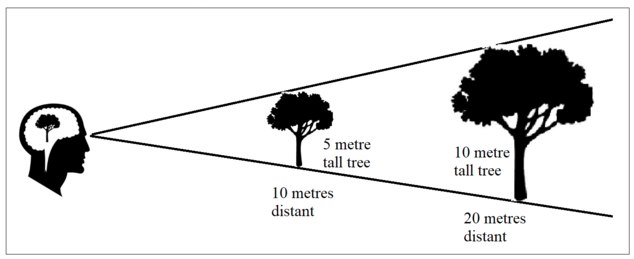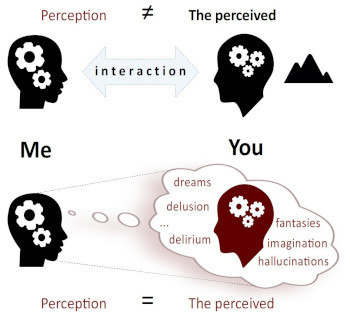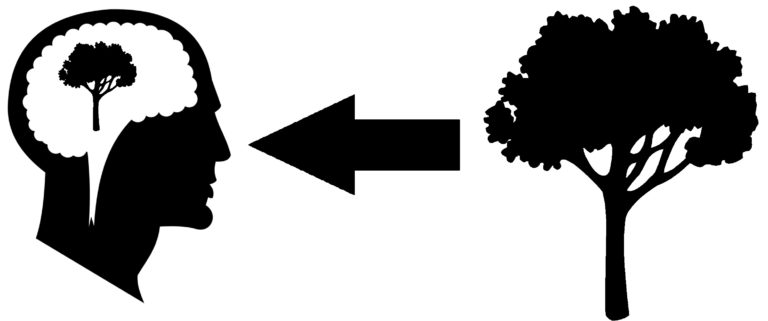-
 frank
18.7kIndirect realism is probably the most prevalent ontological view in the world today. It goes a little like this:
frank
18.7kIndirect realism is probably the most prevalent ontological view in the world today. It goes a little like this:

The question is: does indirect realism undermine itself? If you note in the image above, the indirect scenario has a guy seeing a faulty representation of the object. If this is his only access to the world, can he be an indirect realist without contradiction? In other words, if his view of the world is faulty (or at least possibly unreliable), why should he believe the impressions that led him to consider indirectness in the first place? -
 Mww
5.4kDo we need a different picture? — frank
Mww
5.4kDo we need a different picture? — frank
Yes. Otherwise, you’d be forced to admit the two guy’s eyes don’t work the same way, and by association, it is indeterminable who’s eyes will see the cloud and whose will not, or, the world itself is different depending on who is looking at it, any one of which gets you into all kindsa trouble. -
 Mww
5.4k
Mww
5.4k
The guy on the left. Take away the figure in his head, put in the cloud with the figure in it. The cloud indicates the figure is a representation of the object, the real object perceived directly but represented indirectly.
Notice there’s nothing indicating the operation of the senses, in the second illustration. And notice the figure is in the head, beyond sensory apparatus. This indicates the brain works with that which is not given from the senses, but rather, works with the representations for which the senses merely provide the occassion. -
 frank
18.7kThe guy on the left. Take away the figure in his head, put in the cloud with the figure in it. The cloud indicates the figure is a representation of the object, the real object perceived directly but represented indirectly. — Mww
frank
18.7kThe guy on the left. Take away the figure in his head, put in the cloud with the figure in it. The cloud indicates the figure is a representation of the object, the real object perceived directly but represented indirectly. — Mww
The guy on the left is an image of direct realism. He doesn't get a cloud. He just directly sees the tree. But your comment does say something about this topic. You can quickly get lost with the representations that people see, except the tree is in their head, but it can't be, so what's that in the guy's head? Is it a representation or is it a tree? How do you get a tree in your head? You can't get a tree in your head, so you have to have a cloud with a tree in it.
Notice there’s nothing indicating the operation of the senses, in the second illustration. And notice the figure is in the head, beyond sensory apparatus. This indicates the brain works with that which is not given from the senses, but rather, works with the representations for which the senses merely provide the occassion. — Mww
I don't think there are any representations in direct realism. Maybe you get a little tree? A head-sized tree? -
 plaque flag
2.7k
plaque flag
2.7k
I don't know which 'ism' fits this approach best, but I suggest that the perspective metaphor is useful here. We don't see a picture of the tree. We see the tree 'with' or 'through' our nervous systems 'from' this or that bodily-linguistic perspective. Personality is mediation, but mediation need not and seemingly ought not be understood to cast up a second image of the tree.
Brains and trees need to be kept in the same world of inferential-causal 'plane,' else (seems to me) nonsense ensues, though it's not obvious nonsense. -
 frank
18.7kPersonality is mediation, but mediation need not and seemingly ought not be understood to cast up a second image of the tree. — green flag
frank
18.7kPersonality is mediation, but mediation need not and seemingly ought not be understood to cast up a second image of the tree. — green flag
Ok, but just consider indirect realism for a moment. The idea is that the world around you is a product of your bodily apparatus. The world you take to be real is a collage of representations.
Is this view self undermining? -
 Mww
5.4kHe just directly sees the tree. — frank
Mww
5.4kHe just directly sees the tree. — frank
Everyone directly sees the tree.
I don't think there are any representations in direct realism. — frank
Maybe not, but there are representations necessarily. It is impossible that there are not. Or if not representations, than something that supports the fact that the real object directly sensed, is not what is present in the brain.
The confusion is in what the terms themselves are meant to indicate. What we perceive is real directly; what our cognitive system works with, is real indirectly. -
 plaque flag
2.7k..The world you take to be real is a collage of representations.
plaque flag
2.7k..The world you take to be real is a collage of representations.
Is this view self undermining? — frank
I think so. The brain which is supposed to generate the picture is part of the picture. All arguments for the brain throwing up a picture depend on features of the very picture which is 'derealized' and not be trusted. Brains become the creations of brains. Sense organs become the creation of the very same sense organs, themselves. Note that the dreamer is part of the dream. It doesn't make sense. It eats itself.
There is and can be only one 'inferential-causal nexus.' -
 frank
18.7kEveryone directly sees the tree. — Mww
frank
18.7kEveryone directly sees the tree. — Mww
Maybe not, but there are representations necessarily. — Mww
I'm not sure you're getting the distinction between direct and indirect realism. Or maybe I'm not.
With direct realism, there are no representations. In some way unknown to cognitive science, the spectator is somehow seeing the earth with no intermediary constructions involved. As you mention, it's a problematic view, which is why indirect realism is the view of the "man on the street" as Searle the serial sexual harasser put it.
The confusion is in what the terms themselves are meant to indicate. What we perceive is real directly; what our cognitive system works with, is real indirectly. — Mww
How do you know that? -
 frank
18.7kI think so. The brain which is supposed to generate the picture is part of the picture. All arguments for the brain throwing up a picture depend on features of the very picture which is 'derealized' and not be trusted. Brains (or the 'illusions' thereof) becomes the creations of brains (of their illusory selves). The sense organs become the creation of ... the sense organs. Note that the dreamer is part of the dream. It doesn't — green flag
frank
18.7kI think so. The brain which is supposed to generate the picture is part of the picture. All arguments for the brain throwing up a picture depend on features of the very picture which is 'derealized' and not be trusted. Brains (or the 'illusions' thereof) becomes the creations of brains (of their illusory selves). The sense organs become the creation of ... the sense organs. Note that the dreamer is part of the dream. It doesn't — green flag
:up:
There is and can be only one 'inferential-causal nexus.' — green flag
What does this mean? -
 frank
18.7kI think you're mistaken, frank. "Indirect realism" is an epistemological view (i.e. representationalism) — 180 Proof
frank
18.7kI think you're mistaken, frank. "Indirect realism" is an epistemological view (i.e. representationalism) — 180 Proof
Ok. That's fine. Although it has an ontological dimension wrt the nature of what you take to be the world. Ontology and epistemology are usually joined at the hip I think. -
 Mww
5.4kdistinction between direct and indirect realism — frank
Mww
5.4kdistinction between direct and indirect realism — frank
I do prefer the other names.
What we perceive is real directly; what our cognitive system works with, is real indirectly.
— Mww
How do you know that? — frank
Because I can tell you what a real basketball is, but I promise you there’s never been a real basketball in my head. -
 plaque flag
2.7kWhat does this mean? — frank
plaque flag
2.7kWhat does this mean? — frank
I'm suggesting (exploring the thesis) that our lifeworld and our semantics is inferentially articulated, and that our language ("an organ of perception") is unified, which is to say a system of differences ("without positive terms") with inferential relationships. It's like a game of chess with arbitrary but established names for roles rather than Platonic forms. A bishop by any other names, moves diagonally all the same.
"If I discover that all the boxes in the attic I am charged with cleaning out have been labeled with red, yellow, or green stickers, all I learn is that those labeled with the same color share some property. To learn what they mean is to learn, for instance, that the owner put a red label on boxes to be discarded, green on those to be retained, and yellow on those that needed further sorting and decision. Once I know what follows from affixing one rather than another label, I can understand them not as mere labels, but as descriptions of the boxes to which they are applied.
Description is classification with consequences, either immediately practical (“to be discarded / examined / kept”) or for further classifications. Michael Dummett argues generally that to be understood as conceptually contentful, expressions must have not only circumstances of appropriate application, but also appropriate consequences of application.
That is, one must look not only upstream, to the circumstances (inferential and non-inferential) in which it is appropriate to apply the expression, but also downstream to the consequences (inferential and non-inferential) of doing so, in order to grasp the content it expresses." -
 L'éléphant
1.7k
L'éléphant
1.7k
This is wrong. It's the indirect realist that actually gets it. Their view is not "faulty", rather they acknowledge that their view is a representation of the world-as-it-is.The question is: does indirect realism undermine itself? If you note in the image above, the indirect scenario has a guy seeing a faulty representation of the object. If this is his only access to the world, can he be an indirect realist without contradiction? In other words, if his view of the world is faulty (or at least possibly unreliable), why should he believe the impressions that led him to consider indirectness in the first place? — frank
Also, it is incorrect to contrast the indirect realism with direct realism. The latter is also called the naive realism because the adherents take their perception of the world as the world-as-it-is.
Just for good measure, Banno's thread External world's poll has the non-skeptical realism as one of the choices. That's a fitting description of any realist. -
 unenlightened
10kI am a direct realist, and I do not have a tree in my head. Some people say that I have an image of a tree on the retina of my eye, but if that is true, I certainly cannot see it, because I am busy looking at the tree.
unenlightened
10kI am a direct realist, and I do not have a tree in my head. Some people say that I have an image of a tree on the retina of my eye, but if that is true, I certainly cannot see it, because I am busy looking at the tree.
they acknowledge that their view is a representation of the world-as-it-is. — L'éléphant
One sees sign posts to particularly fine views, and sometimes there is a plaque with sight-lines indicating various features. A view is not a representation; a photo or a painting is a representation of a view. It is quite easy to tell the difference between a real view and a representation of a view, by trying to walk around to the back of it or better still through it.
If the view is of a valley with a fine village with an old pub in it, and you can walk down the hill to the pub and enter and order a beer and drink the beer, then the view was not a representation, whereas if you just get a squashed nose and the taste of paint, it was a representation. I hope this helps. -
 RussellA
2.6kThe guy on the left is an image of direct realism. He doesn't get a cloud. He just directly sees the tree — frank
RussellA
2.6kThe guy on the left is an image of direct realism. He doesn't get a cloud. He just directly sees the tree — frank
You say the Direct Realist is not seeing an image of the tree, which is what the Indirect Realist would say, but is directly seeing the tree.
An Indirect Realist would say that they are looking at an image of the tree, and therefore don't know, just from the image, whether the tree is 5m tall 10m away or is 10m tall 20m away.
If the Direct Realist is directly seeing the tree and not an image of the tree, how does the Direct Realist know, just from the image, whether they are looking at a 5m tall tree 10m away or a 10m tall tree 20m away ?
How can the Direct Realist justify that they are not looking an an image of the tree ?

-
 Metaphysician Undercover
14.7k
Metaphysician Undercover
14.7k
The representation in the op is incorrect. it is inherently biased, direct realist, by showing the external as the same as the image which the direct realist has in mind.
What the diagram needs to show is that the direct realist, and the indirect realist both have the same, or similar image in the mind. But the direct realist thinks that this image is as the external world is, and the indirect realist thinks that it is not.
Indirect realism is a prevalent ontological view because it is supported by ideas derived from modern science. Principally, there is the idea that the world really consists of a bunch of tiny particles moving at a high speed, or perhaps even in some sort of superposition, and objects don't really exist in the way that that they are imaged through sense representation. -
 Mww
5.4kBut your comment does say something about this topic. You can quickly get lost with the representations that people see, except the tree is in their head, but it can't be, so what's that in the guy's head? Is it a representation or is it a tree? — frank
Mww
5.4kBut your comment does say something about this topic. You can quickly get lost with the representations that people see, except the tree is in their head, but it can't be, so what's that in the guy's head? Is it a representation or is it a tree? — frank
Yeah….something said is the superficial silliness of it all on the one hand, re: the implicit absurdity involved in denying there are real basketballs in my head (like…you know…well, DUH!!!), and the fascinating complexity of an organ that can present itself as, or make it seem like there is, a subject present, that the subject has images of things……when (gasp) there never really is either subject or image to be found anywhere in that organ. -
 jorndoe
4.2kThere's something off about the in/direct dichotomy.
jorndoe
4.2kThere's something off about the in/direct dichotomy.
Does direct mean that the perceived becomes part of the perceiver? Maybe that the perception and the perceived are the same? Not really. (I think.) Maybe that there's no strange otherworldly theater at work?
The perception is an (interruptible) occurrence, like a process, where perceiver perception perceived are parts of the same larger environment.
Refraction is part of what the swimmer-in-the-water looks like, regardless that the swimmer's head isn't separate from the rest of their body.

Does this work then?

Looks indirect (I think), but at least interruptibility, same environment, and whatever, are clearer/intuitive. The perception is (ontologically) part of the perceiver when occurring. In the image, hallucination is mistaking "≠" for "=", and solipsism is mistaking "=" for non-identity "≠". Different wording, not the in/direct dichotomy. -
 frank
18.7k
frank
18.7k
The contact with the rest of the world is direct. So how can one perceive indirectly a world that he is in direct contact with? — NOS4A2
The ocean contacts the shore, but it's not perceiving the shore. We don't fully understand how perception works, but it's apparent that a multitude of afferent nerves present electrical stimulus to the central nervous system, which is doing something with those impulses that coincides with awareness.
Lets be clear that indirect realism is the dominant view among scientists, because as @Mww noted, direct realism doesn't make any sense on its face. If we directly perceive objects without any nervous interface, how exactly do with do that? Your eyes don't see things. Your ears don't hear things, and your fingers don't feel things. Your central nervous system sees, hears and feels. There clearly is an interface between the CNS and the world. Thus, indirectness appears to be the way it works.
The onus is on direct realists to explain, if only broadly and superficially, how direct realism is supposed to work. Thoughts? -
 Richard B
551Your eyes don't see things. Your ears don't hear things, and your fingers don't feel things. Your central nervous system sees, hears and feels. There clearly is an interface between the CNS and the world. — frank
Richard B
551Your eyes don't see things. Your ears don't hear things, and your fingers don't feel things. Your central nervous system sees, hears and feels. There clearly is an interface between the CNS and the world. — frank
When I enter a room and turn the light switch off, I do not see, “my eyes do not see”, and “my nervous system does not see”. Clearly, there is an interface between the light switch and the world.
Long live “indirect realism”.
Welcome to The Philosophy Forum!
Get involved in philosophical discussions about knowledge, truth, language, consciousness, science, politics, religion, logic and mathematics, art, history, and lots more. No ads, no clutter, and very little agreement — just fascinating conversations.
Categories
- Guest category
- Phil. Writing Challenge - June 2025
- The Lounge
- General Philosophy
- Metaphysics & Epistemology
- Philosophy of Mind
- Ethics
- Political Philosophy
- Philosophy of Art
- Logic & Philosophy of Mathematics
- Philosophy of Religion
- Philosophy of Science
- Philosophy of Language
- Interesting Stuff
- Politics and Current Affairs
- Humanities and Social Sciences
- Science and Technology
- Non-English Discussion
- German Discussion
- Spanish Discussion
- Learning Centre
- Resources
- Books and Papers
- Reading groups
- Questions
- Guest Speakers
- David Pearce
- Massimo Pigliucci
- Debates
- Debate Proposals
- Debate Discussion
- Feedback
- Article submissions
- About TPF
- Help
More Discussions
- Other sites we like
- Social media
- Terms of Service
- Sign In
- Created with PlushForums
- © 2026 The Philosophy Forum

















